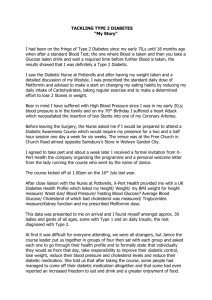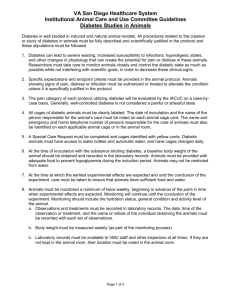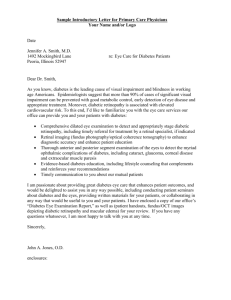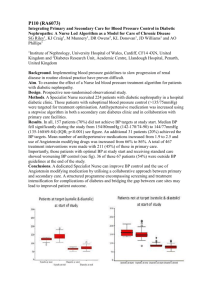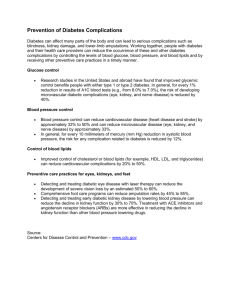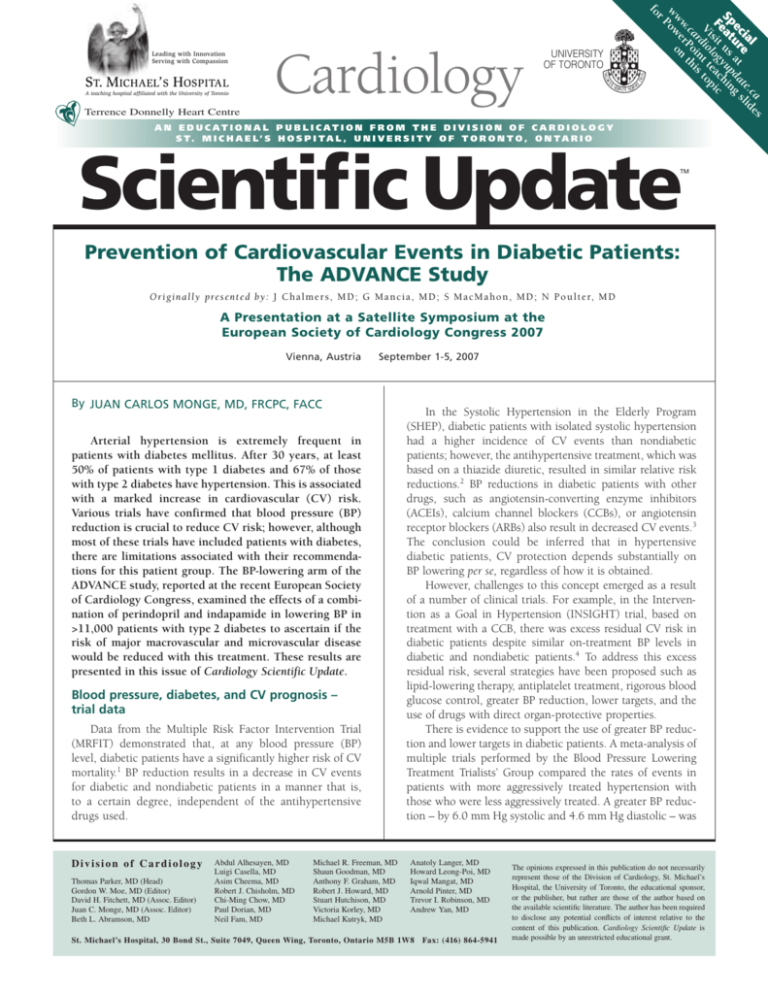
ST. MICHAEL’S HOSPITAL
A teaching hospital affiliated with the University of Toronto
Cardiology
UNIVERSITY
OF TORONTO
Terrence Donnelly Heart Centre
s
l
.ca de
ia e
te li
ec u r at da g s
Sp eat us yup hin
F it log eac ic
s
Vi dio t t top
r in s
ca o hi
w. erP n t
wwPow o
r
fo
Leading with Innovation
Serving with Compassion
A N E D U C AT I O N A L P U B L I C AT I O N F R O M T H E D I V I S I O N O F C A R D I O L O G Y
S T. M I C H A E L ’ S H O S P I T A L , U N I V E R S I T Y O F T O R O N T O , O N T A R I O
Scientific Update
TM
Prevention of Cardiovascular Events in Diabetic Patients:
The ADVANCE Study
Or igin a lly p resen t ed by : J C h a l m e r s , M D ; G M a n c i a , M D ; S M a c M a h o n , M D ; N P o u l t e r, M D
A Presentation at a Satellite Symposium at the
European Society of Cardiology Congress 2007
Vienna, Austria
September 1-5, 2007
By JUAN CARLOS MONGE, MD, FRCPC, FACC
Arterial hypertension is extremely frequent in
patients with diabetes mellitus. After 30 years, at least
50% of patients with type 1 diabetes and 67% of those
with type 2 diabetes have hypertension. This is associated
with a marked increase in cardiovascular (CV) risk.
Various trials have confirmed that blood pressure (BP)
reduction is crucial to reduce CV risk; however, although
most of these trials have included patients with diabetes,
there are limitations associated with their recommendations for this patient group. The BP-lowering arm of the
ADVANCE study, reported at the recent European Society
of Cardiology Congress, examined the effects of a combination of perindopril and indapamide in lowering BP in
>11,000 patients with type 2 diabetes to ascertain if the
risk of major macrovascular and microvascular disease
would be reduced with this treatment. These results are
presented in this issue of Cardiology Scientific Update.
Blood pressure, diabetes, and CV prognosis –
trial data
Data from the Multiple Risk Factor Intervention Trial
(MRFIT) demonstrated that, at any blood pressure (BP)
level, diabetic patients have a significantly higher risk of CV
mortality.1 BP reduction results in a decrease in CV events
for diabetic and nondiabetic patients in a manner that is,
to a certain degree, independent of the antihypertensive
drugs used.
Division of Cardiology
Thomas Parker, MD (Head)
Gordon W. Moe, MD (Editor)
David H. Fitchett, MD (Assoc. Editor)
Juan C. Monge, MD (Assoc. Editor)
Beth L. Abramson, MD
Abdul Alhesayen, MD
Luigi Casella, MD
Asim Cheema, MD
Robert J. Chisholm, MD
Chi-Ming Chow, MD
Paul Dorian, MD
Neil Fam, MD
Michael R. Freeman, MD
Shaun Goodman, MD
Anthony F. Graham, MD
Robert J. Howard, MD
Stuart Hutchison, MD
Victoria Korley, MD
Michael Kutryk, MD
In the Systolic Hypertension in the Elderly Program
(SHEP), diabetic patients with isolated systolic hypertension
had a higher incidence of CV events than nondiabetic
patients; however, the antihypertensive treatment, which was
based on a thiazide diuretic, resulted in similar relative risk
reductions.2 BP reductions in diabetic patients with other
drugs, such as angiotensin-converting enzyme inhibitors
(ACEIs), calcium channel blockers (CCBs), or angiotensin
receptor blockers (ARBs) also result in decreased CV events.3
The conclusion could be inferred that in hypertensive
diabetic patients, CV protection depends substantially on
BP lowering per se, regardless of how it is obtained.
However, challenges to this concept emerged as a result
of a number of clinical trials. For example, in the Intervention as a Goal in Hypertension (INSIGHT) trial, based on
treatment with a CCB, there was excess residual CV risk in
diabetic patients despite similar on-treatment BP levels in
diabetic and nondiabetic patients.4 To address this excess
residual risk, several strategies have been proposed such as
lipid-lowering therapy, antiplatelet treatment, rigorous blood
glucose control, greater BP reduction, lower targets, and the
use of drugs with direct organ-protective properties.
There is evidence to support the use of greater BP reduction and lower targets in diabetic patients. A meta-analysis of
multiple trials performed by the Blood Pressure Lowering
Treatment Trialists’ Group compared the rates of events in
patients with more aggressively treated hypertension with
those who were less aggressively treated. A greater BP reduction – by 6.0 mm Hg systolic and 4.6 mm Hg diastolic – was
Anatoly Langer, MD
Howard Leong-Poi, MD
Iqwal Mangat, MD
Arnold Pinter, MD
Trevor I. Robinson, MD
Andrew Yan, MD
St. Michael’s Hospital, 30 Bond St., Suite 7049, Queen Wing, Toronto, Ontario M5B 1W8 Fax: (416) 864-5941
The opinions expressed in this publication do not necessarily
represent those of the Division of Cardiology, St. Michael’s
Hospital, the University of Toronto, the educational sponsor,
or the publisher, but rather are those of the author based on
the available scientific literature. The author has been required
to disclose any potential conflicts of interest relative to the
content of this publication. Cardiology Scientific Update is
made possible by an unrestricted educational grant.
associated with a significant 36% reduction in stroke and
31% reduction in congestive heart failure. There were also
reductions in coronary events and CV events, but they failed
to achieve statistical significance.3
A retrospective analysis of the Irbesartan Diabetic
Nephropathy Trial (IDNT) also demonstrated that diabetic
patients who achieved on-treatment BP levels that were
<130 mm Hg systolic had an almost 40% reduction in the
risk of heart failure compared to those remaining around 140
mm Hg systolic.5
In the diabetic subgroup of the Hypertension Optimal
Treatment (HOT) trial, patients randomized to a target diastolic BP (DBP) of 80 mm Hg had a 50% reduction in major
CV events compared to those randomized to the more traditional target of 90 mm Hg.6
Similar benefits have been observed in diabetic patients
with relatively normal, or only minimally elevated BPs, such
as those enrolled in the MICRO-HOPE substudy that included
3,577 high-risk diabetic patients randomized to an ACEI or
placebo. Patients treated with the ACEI had significant
reductions in myocardial infarction (MI), stroke, CV death,
total mortality, and microvascular disease.7
In a small study, the Appropriate Blood Pressure Control
in Diabetes (ABCD) study, patients with moderate BP reduction (on-treatment level of 137/81 mm Hg) were compared
with patients treated with more intensive BP-lowering to a
level of 128/75 mm Hg. The latter had a significant reduction
in the risk of stroke compared with the less intensivelytreated patients.8
Limitations of these studies in regards
to diabetic patients
Evidence from the above studies led to the inclusion of
recommendations for more aggressive BP lowering in diabetic patients in the major guidelines, as well as the initiation
of treatment at high normal BP levels (≥130/85 mm Hg in
the recent European guidelines or ≥130/80 mm Hg in the
Canadian guidelines), and the use of drugs that target the
renin-angiotensin system.9,10
However, there are some limitations for these recommendations in the guidelines – as they pertain to diabetic patients
– that need to be acknowledged. These include the fact that
few specific studies have been conducted; the studies have
often been small in size; the data are largely based on subgroup analysis of studies on general hypertensive populations;
the studies make extensive use of retrospective analysis; the
CV endpoints were often secondary outcomes of studies with
primary renal endpoints; and evidence is particularly limited
about the benefits of treating individuals in the normotensive
range (defined as a BP of <140/90 mm Hg).
Another important aspect that should be considered is
the complexity of treating hypertension in diabetic patients.
Most studies have demonstrated the need to use multiple
drugs, since monotherapy is almost always insufficient to
control BP to recommended targets in this patient population.11-13 Some guidelines, however, are somewhat circumspect about recommending combination therapy, given the
potential need for a large number of pills, the issue of cost,
and the possibility of increased side effects, among other
reasons. Moreover, an analysis of studies that included hypertensive diabetic patients revealed that most could not lower
SBP below 140 mm Hg (an average on-treatment value) in
these patients and not a single study reached the recommended target of 130 mm Hg.14
There is a significant need, therefore, for more effective,
simpler, and safer treatments to achieve greater BP reductions
and better long-term BP control in diabetic patients that
could lead to reduced morbidity and mortality. This is even
more important in the clinical setting, in which the levels of
BP control observed in clinical trials are rarely achieved and
the difficulties outlined above are often magnified. For
example, the ForLife study, conducted in Italy, assessed BP
control in >12,000 patients followed by general practitioners,
including 2,491 with diabetes. Only 14.9% of the diabetic
patients achieved BP levels of <140/90 mm Hg and only a
minute number (3.0%) had their BP lowered to the guideline-recommended level of <130/80 mm Hg.13
The ADVANCE study
It is currently estimated that there are 247 million people
with diabetes in the world and this number is projected to
reach 380 million in the year 2025, an increase of 55% in the
next 2 decades alone. It is recognized that most people with
diabetes will die from the vascular complications of the
disease, rather than from its metabolic complications.
The United Kingdom Prospective Diabetes Study
(UKPDS) demonstrated that tighter BP control reduced the
risk of any clinical endpoint, fatal or nonfatal, related to
diabetes. It also demonstrated a continuous relationship
between BP levels and risk of macrovascular and microvascular events.16 However, all subjects included in UKPDS
started in the hypertensive range and were still in that range
at study conclusion. The less tightly-controlled group
finished with a SBP of 154 mm Hg, while the more tightlycontrolled group had a level of 145 mm Hg.
Rationale
This is the landscape in which the “Action in Diabetes
and Vascular Disease: Preterax and Diamicron MR Controlled Evaluation” (ADVANCE) study was conceived.17 (The
fixed combination of perindopril and indapamide is known
by the trade name COVERSYL Plus in Canada.) In 2000,
ADVANCE was designed to address these unresolved
questions: Does BP-lowering therapy in diabetics produce
Cardiology
Scientific Update
additional benefits when SBP is lowered to <145 mm Hg,
going beyond UKPDS and into the normotensive range;
would BP lowering result in similar benefits in hypertensive
and nonhypertensive patients; and would it add to the benefits
of other CV preventive therapies, including ACEIs?
Design
ADVANCE is a factorial, randomized trial of BP-lowering
and intensive glucose control in 11,140 patients with type 2
diabetes. The BP-lowering arm was recently reported, while
the intensive glucose-control arm is ongoing.18 The factorial
design included a double-blind, placebo-controlled comparison of BP-lowering with a fixed combination of perindopril
and indapamide and an open comparison (PROBE design
[prospective, randomized, open-label therapy with blind
endpoint analysis]) of a glicazide MR-based regimen for
intensive glucose control.
The 11,140 patients were from a wide range of geographic regions, including Caucasian and Asian patients from
multiple countries and continents, and were followed for
4-5 years. The hypotheses were that among individuals with
type 2 diabetes, the routine addition of a fixed combination
of perindopril and indapamide would reduce the risks of
major macrovascular disease (including coronary disease,
cerebrovascular disease, or death from CV disease), and
major microvascular disease (including new or worsening
nephropathy or diabetic eye disease). Additionally, it was
hypothesized that these results would occur irrespective of
initial BP or the background use of other preventive therapies, including ACEIs.
Randomization followed a 6-week, run-in period, during
which patients were given open-label perindopril and
indapamide. Patients were randomized to the perindoprilindapamide fixed-combination or placebo in the BP-lowering
arm, and in the glucose control arm to intensive therapy
targeting an A1c level of 6.5% or to standard glucose control
according to local guidelines.
The inclusion criteria included type 2 diabetes, age
≥55 years, and additional vascular risk factors that could be
age >65 years, a history of major macrovascular disease,
a history of major microvascular disease, a diagnosis of
diabetes made >10 years prior to entry or one of the major
traditional CV risk factors. Importantly, patients could be
hypertensive or normotensive.
The randomized study treatments in the BP arm were
double-blind perindopril and indapamide versus matching
placebo, starting at a dose of 2 mg of perindopril and 0.625
mg of indapamide for the first 3 months, increasing automatically in all patients to 4 mg and 1.25 mg, respectively,
thereafter. The fixed-combination of perindopril and indapamide was chosen because it has been shown to be very
effective in lowering BP and preventing recurrent strokes and
CV events.19 The combination is well-tolerated and has other
potentially desirable properties, such as reducing arterial stiffness in large arteries and enhancing the function of the microcirculation and tissue perfusion in the heart and kidney.20-25
There was, therefore, a strong rationale to expect clinical
benefits in diabetic patients, in whom vascular disease straddles the microvasculature and the macrovasculature.
Any ancillary antihypertensive treatment that the treating
physician considered necessary was allowed in ADVANCE,
with the exception of thiazide diuretics. Open-label perindopril was made available to the patients if the treating physician considered that an ACEI was indicated. The primary
outcomes were a composite macrovascular endpoint that
included: nonfatal stroke, nonfatal MI or death from any CV
cause, including sudden cardiac death, and a composite
microvascular endpoint of new or worsening nephropathy or
diabetic eye disease. It was prespecified that the macrovascular and the microvascular endpoints would be analyzed
jointly, as well as separately.
Study population
A total of 12,877 patients were registered and 11,140
were randomized after the 6-week run-in period. The study
population represented a broad cross-section of diabetic
patients from Australia, New Zealand, several countries in
the Asia-Pacific region (including large numbers of patients
from India, China, Malaysia, and the Philippines, among
others), Europe, and Canada. At baseline, the mean age of
the patients was 65 years and SBP was 145 mm Hg, which is
exactly where UKPDS left off. The DBP was normal at 81 mm
Hg and hemoglobin A1c was 7.5%.
ADVANCE Study:
morbidity and mortality results
After randomization, there were 5,569 patients assigned
to the perindopril-indapamide combination and 5,571 to the
control group. Following an average follow-up period of 4.3
years, only 15 patients were lost to follow-up. The SBP in the
perindopril-indapamide-treated group was 5.6 mm Hg lower
than in the control group. The difference in the DBP was
2.2 mm Hg. The average BP during follow-up was 134.7/
74.8 mm Hg for the combination-treated group compared to
140.3/77.0 mm Hg for the control group (Figure 1). There
was an excellent use of ancillary drug therapy in the study.
For example, in the control group, 83% of the patients
received antihypertensive medications, including 60% of the
patients who were given open-label perindopril.
There was a significant 14% reduction in the secondary
endpoint of all-cause mortality with the perindopril-indapamide combination. The benefits were seen beginning at
12 months and continued to accrue throughout the followup period (Figure 2). The reduction in all-cause mortality
Cardiology
Scientific Update
Mean blood pressure (mmHg)
Figure 1: Blood pressure reduction
165
155
145
135
125
115
105
95
85
75
65
Placebo
Perindopril-indapamide
145
Figure 3: Deaths
Average BP
during follow-up
Systolic
140.3 mmHg
134.7 mmHg
137
Δ 5.6 mmHg (95% CI, 5.2-6.0); p<0.001
Cardiovascular
5%
Diastolic
78
4%
3%
3%
2%
2%
R
6
0%
77.0 mmHg
74.8 mmHg
Δ 2.2 mmHg (95% CI, 2.0-2.4); p<0.001
Noncardiovascular
5%
4%
1%
81
Placebo
Perindopril-indapamide
HR 0.82
(95% CI, 0.68-0.98) p=0.027
1%
0%
Placebo
Perindopril-indapamide
HR 0.92
(95% CI, 0.76-1.12) p=0.41
6 12 18 24 30 36 42 48 54 60
6 12 18 24 30 36 42 48 54 60
Follow-up (months)
Follow-up (months)
12 18 24 30 36 42 48 54 60
Follow-up (months)
primarily reflected a reduction in CV deaths, which were
reduced by a significant 18% (Figure 3). The combined
primary outcome of macrovascular and microvascular
events was reduced by 9% (Figure 4). The separate
analysis of these primary outcomes demonstrated nearly
identical beneficial trends for the prevention of both of
these types of events with the perindopril-indapamide
combination. Total coronary events were reduced by a
significant 14%. The reduction of 6% in cerebrovascular
events did not reach statistical significance. There was
also a highly significant 21% reduction in renal events,
including new or worsening nephropathy and new-onset
microalbuminuria. There was a 5% reduction in eye
events with the combination that barely failed to reach
statistical significance.
In terms of the absolute benefits of routine treatment
of similar patients with the combination of perindopril
and indapamide, it would be expected to prevent 1 major
vascular event among 66 treated patients, 1 death among
79 patients, 1 coronary event among 75 patients, and
1 renal event among 20 patients (primarily new-onset
microalbuminuria). These can be considered fairly reasonable benefits in the context of primary or secondary
Figure 2: All-cause mortality
Cumulative incidence (%)
10
Placebo
Perindopril-indapamide
8
6
4
Hazard ratio=0.86
95% CI, 0.75-0.98
p=0.025
2
0
0
6
12
18
24
30
36
42
Follow-up (months)
48
54
60
prevention of CV disease. The benefits of treatment were
present and largely similar in multiple subgroups that
were analyzed (eg, patients aged ±65 years, male or female
sex, SBP ± 140 mm Hg, and hemoglobin A1c ± 7.5%.
Importantly, the benefits were in addition to those
produced by other treatments, including the high use of
open-label ACEIs in the control group, and were achieved
with remarkable safety and tolerability as reflected by
very few withdrawals due to intolerance.
The impact of ADVANCE on the management
of diabetic patients
The analysis of the impact of less intensive versus
more intensive BP-lowering in diabetic patients conducted by the Blood Pressure Lowering Treatment
Trialists’ Collaboration (BPLTTC) suggested the benefits
of the latter approach on the endpoints of stroke, coronary heart disease, and heart failure.3,26 Although not all
of the endpoints reached statistical significance, this
study suggested that diabetic patients did at least as well,
if not better, than nondiabetic hypertensive patients with
the more intensive approach to lowering BP. As discussed
previously, in the UKPDS, lowering SBP to 144 mm Hg
resulted in additional benefits compared to a level of 154
mm Hg in the less intensively-treated diabetic patients.
However, BP levels in these studies would not be considered acceptable at this time.
When ADVANCE was designed, there were several
important unresolved issues related to BP-lowering in
diabetic patients. For instance, it was not known whether
lowering SBP to <145 mm Hg would produce additional
benefits or whether these benefits would be observed
both in hypertensive and nonhypertensive diabetics. The
BP levels of the patients studied in ADVANCE, beginning
where UKPDS left off, are more commonly seen in the
current diabetic population and are, therefore, more
relevant to contemporary clinical practice. Importantly,
in ADVANCE, the treatment of type 2 diabetics with
the fixed perindopril-indapamide combination yielded
Cardiology
Scientific Update
Figure 4: Primary outcomes – Major macro- or microvascular event
Number of events
Per-Ind
Placebo
(n=5,569) (n=5,571)
Favours Favours
Per-Ind Placebo
Relative risk
reduction (95%)
Combined macro+micro
861
938
9% (0 to 17)*
Macrovascular
480
520
8% (-4 to 19)
Microvascular
439
477
9% (-4 to 20)
0.5
1.0
Hazard ratio
2.0
*2P=0.04
Per-Ind = perindopril-indapamide
outcome benefits, irrespective of the initial BP or the
background use of other preventive therapies, including
ACE inhibitors.
The risk reduction in coronary events in the study
was almost identical to what would have been expected
based on the results of the BPLTTC. The reduction in
stroke was somewhat less than expected, but the confidence intervals for this endpoint were rather wide and
generally compatible with the previous evidence of the
large number of trials included in the BPLTTC analysis.
The large 14% reduction in total mortality observed in
ADVANCE is greater than would have been expected
from BPLTTC, but the confidence intervals also cross the
expected data from the Collaboration. The reduction in
total mortality was largely driven by an 18% reduction
in CV mortality, which is also greater than expected;
however, the same caution must be exercised as with the
total mortality data.
It is also important to put ADVANCE in context by
comparing it to other similar large trials of diabetic
patients. While UKPDS included 1,148 patients and
Table 1: ADVANCE in context: Comparative patient
profiles: UKPDS, MICRO-HOPE, ADVANCE
UKPDS MICRO-HOPE ADVANCE
BP levels (mm Hg)
145/82
Active treatment at end follow-up
139/77
136/73
No
Yes
No
+
++
8.3%
9.5%
6.9%
+++
++
+++
+++
+
+
Use of background ACEI No
Use of statins
A1c end follow-up
Event rate,
Total and CV mortality
Stroke
MICRO-HOPE included 3,577, ADVANCE is a much
larger trial, including >11,000 patients. Additionally,
ADVANCE took BP to levels that are lower than in the
other 2 studies (UKPDS: 145/82 mm Hg, MICRO-HOPE:
139 / 77 mm Hg, and ADVANCE: 136 / 73 mm Hg),
providing strong evidence to support more aggressive
BP-lowering in diabetic patients. The use of statins was
greater in ADVANCE than in MICRO-HOPE, while no
statins were used in UKPDS. Glucose control was also
much better in ADVANCE as reflected by A1c levels of
6.9%, as compared to 8.3% in UKPDS and 9.5% in
MICRO-HOPE.7,16-18 The event rates for total mortality,
CV mortality, and stroke were lower in ADVANCE than
in the other 2 studies, reflecting the fact that this was a
lower risk population treated with more appropriate
contemporary CV preventive therapies (Table 1).
Summary
The potential implications of ADVANCE can be estimated by examining the current prevalence of diabetes
worldwide, which is estimated to be 246 million. Treating
only half of the population with the fixed combination
used in ADVANCE would have the potential of averting
311,000 deaths per year, based on a number needed to
treat (NNT) of 79 patients for 5 years to prevent 1 death.
This exercise assumes, of course, that the NNT can be
generalized to the overall diabetic population and is
simply meant to illustrate the potentially massive impact
of a wide application of the findings of ADVANCE.
Currently, the United States (JNC-7) and European
(ESH-ESC) guidelines for the treatment of hypertension
recommend the use of 2-drug combination therapy as
first-line treatment under certain circumstances. For
instance, the latter includes patients at high-risk, such as
diabetics, as one of the possible situations in which a
Cardiology
Scientific Update
low-dose 2-drug combination could be used as first-line
treatment.
It must be noted, however, that no large clinical trial
evidence exists to support the recommendation of most
guidelines to lower BP in diabetics to <130/80 mm Hg. This
recommendation is largely based on observational studies.
The evidence from ADVANCE is a significant contribution,
since the BP level that has been studied and shown to be
beneficial in clinical trials is more in line with the guidelines
and attests to the validity of their recommendations. As
such, and in addition to the potential large benefits of the
widespread use of the fixed combination, ADVANCE is a
landmark trial that greatly advances our knowledge of the
prevention of CV events in type 2 diabetic patients.
14. Mancia G, Grassi G. Systolic and diastolic blood pressure control in antihypertensive drug trials. J Hypertens 2002;20:1461-1464.
15. Mancia G, Ambrosioni E, Rosei EA, et al. Blood pressure control and risk of
stroke in untreated and treated hypertensive patients screened from clinical
practice: results of the ForLife study. J Hypertens 2005;23:1575-1581.
16. Tight blood pressure control and risk of macrovascular and microvascular
complications in type 2 diabetes: UKPDS 38. UK Prospective Diabetes Study
Group. BMJ 1998;317:703-713.
17. Study rationale and design of ADVANCE: action in diabetes and vascular
disease--preterax and diamicron MR controlled evaluation. Diabetologia 2001;
44:1118-1120.
18. Patel A, MacMahon S, Chalmers J, et al. Effects of a fixed combination of
perindopril and indapamide on macrovascular and microvascular outcomes in
patients with type 2 diabetes mellitus (the ADVANCE trial): a randomised
controlled trial. Lancet 2007;370:829-840.
19. Randomised trial of a perindopril-based blood-pressure-lowering regimen
among 6,105 individuals with previous stroke or transient ischaemic attack.
Lancet 2001;358:1033-1041.
20. Asmar RG, London GM, O'Rourke ME, et al. Improvement in blood pressure,
arterial stiffness and wave reflections with a very-low-dose perindopril/
indapamide combination in hypertensive patient: a comparison with atenolol.
Hypertension 2001;38:922-926.
21. Lacourciere Y, Beliveau R, Conter HS, et al. Effects of perindopril on elastic and
structural properties of large arteries in essential hypertension. Can J Cardiol
2004;20:795-799.
22. Manolis AJ, Iraklianou S, Pittaras A, et al. Arterial compliance changes in
diabetic normotensive patients after angiotensin-converting enzyme inhibition
therapy. Am J Hypertens 2005;18:18-22.
23. Ahimastos AA, Aggarwal A, D’Orsa KM, et al. Effect of perindopril on large
artery stiffness and aortic root diameter in patients with Marfan syndrome: a
randomized controlled trial. JAMA 2007;298:1539-1547.
24. Buus NH, Bottcher M, Jorgensen CG, et al. Myocardial perfusion during longterm angiotensin-converting enzyme inhibition or beta-blockade in patients
with essential hypertension. Hypertension 2004;44:465-470.
25. Mourad JJ, Laville M. Is hypertension a tissue perfusion disorder? Implications
for renal and myocardial perfusion. J Hypertens Suppl 2006;24:S10-S16.
26. Neal B, MacMahon S, Chapman N. Effects of ACE inhibitors, calcium
antagonists, and other blood-pressure-lowering drugs: results of prospectively
designed overviews of randomised trials. Blood Pressure Lowering Treatment
Trialists’ Collaboration. Lancet 2000;356:1955-1964.
Reference List
1. Stamler J, Vaccaro O, Neaton JD et al. Diabetes, other risk factors, and 12-yr
cardiovascular mortality for men screened in the Multiple Risk Factor
Intervention Trial. Diabetes Care 1993;16:434-444.
2. Curb JD, Pressel SL, Cutler JA, et al. Effect of diuretic-based antihypertensive
treatment on cardiovascular disease risk in older diabetic patients with isolated
systolic hypertension. Systolic Hypertension in the Elderly Program
Cooperative Research Group. JAMA 1996;276:1886-1892.
3. Turnbull F, Neal B, Algert C, et al. Effects of different blood pressure-lowering
regimens on major cardiovascular events in individuals with and without
diabetes mellitus: results of prospectively designed overviews of randomized
trials. Arch Intern Med 2005;165:1410-1419.
4. Mancia G, Brown M, Castaigne A, et al. Outcomes with nifedipine GITS or Coamilozide in hypertensive diabetics and nondiabetics in Intervention as a Goal
in Hypertension (INSIGHT). Hypertension 2003;41:431-436.
5. Berl T, Hunsicker LG, Lewis JB, et al. Impact of achieved blood pressure on
cardiovascular outcomes in the Irbesartan Diabetic Nephropathy Trial. J Am
Soc Nephrol 2005;16:2170-2179.
6. Hansson L, Zanchetti A, Carruthers SG, et al. Effects of intensive bloodpressure lowering and low-dose aspirin in patients with hypertension:
principal results of the Hypertension Optimal Treatment (HOT) randomised
trial. HOT Study Group. Lancet 1998;351:1755-1762.
7. Effects of ramipril on cardiovascular and microvascular outcomes in people
with diabetes mellitus: results of the HOPE study and MICRO-HOPE substudy.
Heart Outcomes Prevention Evaluation Study Investigators. Lancet 2000;355:
253-259.
8. Schrier RW, Estacio RO, Esler A, et al. Effects of aggressive blood pressure
control in normotensive type 2 diabetic patients on albuminuria, retinopathy
and strokes. Kidney Int 2002;61:1086-1097.
9. Mancia G, De Backer G, Dominiczak A, et al. 2007 ESH-ESC Practice
Guidelines for the Management of Arterial Hypertension: ESH-ESC Task Force
on the Management of Arterial Hypertension. J Hypertens 2007;25:1751-1762.
10. Khan NA, Hemmelgarn B, Padwal R, et al. The 2007 Canadian Hypertension
Education Program recommendations for the management of hypertension:
part 2 - therapy. Can J Cardiol 2007;23:539-550.
11. Bakris GL, Williams M, Dworkin L, et al. Preserving renal function in adults
with hypertension and diabetes: a consensus approach. National Kidney
Foundation Hypertension and Diabetes Executive Committees Working
Group. Am J Kidney Dis 2000;36:646-661.
12. Brenner BM, Cooper ME, de Zeeuw D, et al. Effects of losartan on renal and
cardiovascular outcomes in patients with type 2 diabetes and nephropathy.
N Engl J Med 2001;345:861-869.
13. Lewis EJ, Hunsicker LG, Clarke WR, et al. Renoprotective effect of the
angiotensin-receptor antagonist irbesartan in patients with nephropathy due to
type 2 diabetes. N Engl J Med 2001;345:851-860.
Dr. Monge has stated that he has no disclosures to announce in association
with the contents of this issue.
SNELL Medical Communication acknowledges that it has received
an unrestricted educational grant from Servier Canada to support
the distribution of this issue of Cardiology Scientific Update. Acceptance of this grant was conditional upon the sponsors’ acceptance
of the policy established by the Division of Cardiology, St. Michael’s
Hospital, and SNELL Medical Communication guaranteeing the
educational integrity of the publication. This policy ensures that
the author and editor will at all times exercise unrestricted, rigorous, scientific independence free of interference from any other
party.
© 2007 Division of Cardiology, St. Michael’s Hospital, University of Toronto, which is solely responsible for the contents. Publisher: SNELL Medical Communication Inc. in cooperation with the Division of Cardiology,
St. Michael’s Hospital, University of Toronto. ™Cardiology Scientific Update is a Trade Mark of SNELL Medical Communication Inc. All rights reserved. The administration of any therapies discussed or referred to
in Cardiology Scientific Update should always be consistent with the approved prescribing information in Canada. SNELL Medical Communication Inc. is committed to the development of superior Continuing Medical Education.
Publications Post #40032303
SNELL
202-087

